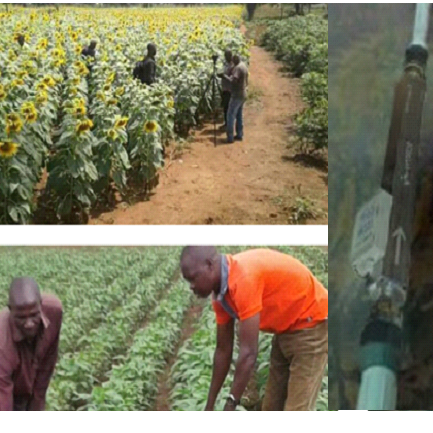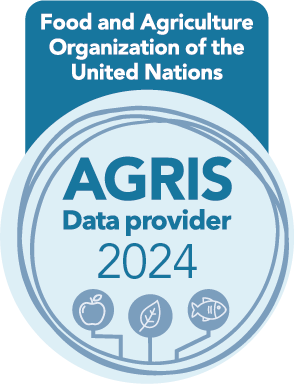Results obtained with EVOagri technology to improve yield using filtered water in Africa, Tibet, Italy and Bulgaria
DOI:
https://doi.org/10.14719/pst.2034Keywords:
EVOdrop technology, Water filtration, Africa, Nepal, Italy, BulgariaAbstract
The effectiveness of the application of EVOagri technology for purification of water and its use in agriculture in some African countries (Zimbabwe, Burundi, Egypt and Uganda), Nepal (Asia) and in Europe (Italy and Bulgaria) was evaluated. The performance of EVOdrop turbine for water filtration was analysed and the physicochemical composition of water was tested. This was determined in compliance with Ordinance No. 9/2001, published in the Official State Gazette, issue 30, and decree No. 178/23.07.2004, Bulgaria, European Union on the quality of water intended for drinking and household purposes. The results showed a significant increase in production yield of the tested Solanum spp. and lettuces in Zimbabwe, as well as of dill, spinach and onions in Egypt. Treatment of high-salt irrigation water in Burundi with EVOagri reduced its toxic effect upon vegetable plants. In Uganda, plants absorbed 23% less water, when filtered with EVOagri technology. In Italy, 21% water conservation was achieved through the usage of EVOagri technology. Stimulation of seed-germination after soaking with EVOagri water was established in Burundi and Nepal. The importance of the type and composition of irrigation water for crop growth was proved by the experiments in Bulgaria. In Bulgaria, onion seeds were planted in two separate pots. The first one was watered with tap water and this was taken as the control sample with tap water. The second one was watered with EVOdrop filtered water which was saturated with EVOdrop hydrogen technology (EVOwater). In Bulgaria, under natural conditions, Evodrop water was also tested in beans and the growth result was 11 % better than the control sample.
Downloads
References
Choukr-Allah, Redouane. Use and management of saline water for irrigation in the Near East and North Africa (NENA) region. 4th Chapter, 2021; 51-68. in Future of Sustainable Agriculture in Saline Environments. CRC Press. Taylor & Fransis, Boca Raton, FL 33487-2742. https://doi.org/10.1201/9781003112327
Wadzanay N I. Results with EvoAgri device. Faculty of Agriculture and Environmental Science. Bindura University of Environmental Science. Zimbabwe. 2020; 30.07.2020.
Funence B. Scientific research of irrigation of saline water with EVOagri device. Higher Institute of Business Management, Republic of Burundi. 2020; 29.05.2020.
Results with EvoAgri device. General Authority for Agrarian Reform. Ministry of Agriculture and Land Reclamation, Egypt. 2021.
Banadda E. Test device EvoAgri from the company Evodrop AG from Switzerland. Directorate. Makkere University. Uganda. 2020.
Bhatta S. Results with EvoAgri device. Department of Soil Science and Agri. Engineering. Faculty of Agriculture. Agriculture and Forestry University. Nepal. 2020.
Ordinance No. 9/2001. (2004). Official State Gazette, issue 30, and Decree No. 178/23.07.2004 regarding the quality of water intended for drinking and household purposes. 2004.
Ignatov I. Physicochemical research of mineral and mountain spring waters in Bulgaria, Asian Journal of Applied Chemistry Research. 2020; 7(2): 40-46. https://doi.org/10.9734/ajacr/2020/v7i230180
Ignatov I, Ignatov A I, Angelcheva M, Angushev I. The international event "Days of Mountain Water". Uttar Pradesh Journal of Zoology. 2022; 43 (12):16-29.
Huether F. Filter system. Fabio and Markus membrane ENG GMBH [CH]WO2020169852A1. 3.01.2019.
Huether F. Water purifier. Fabio and Markus turbine ENG GMBH [CH]WO2020178200A1. 3.01.2019.
Ignatov I, Tsvetkova V. Water for the origin of life and “Informationability” of water, Kirlian (electric images) of different types of water. Euromedica, Hanover. 2011. 62-65.
Ignatov I, Huether F, Neshev N, Kiselova-Kaneva Y, Popova T P, Bankova R, Valcheva N, Ignatov A I, Angelcheva M, Angushev I, Baiti S. Research of water molecules cluster structuring during Haberlea rhodopensis Friv. Hydration. Plants. 2022; 11(19): 2655. https://doi.org/10.3390/plants11192655
Li L, Lou W, Kong L, Shen W. Hydrogen commonly applicable from medicine to agriculture: From molecular mechanisms to the field. Current Pharmaceutical Design. 2021; 27 (5): 747-759 https://doi.org/10.2174/1381612826666201207220051
Hristov P, Yoleva A, Djambazov S, Chukovska I, Dimitrov D. Preparation and characterization of porous ceramic membranes for micro-filtration from natural zeolite. Journal of the University of Chemical Technology and Metallurgy. 2012; 47 (4): 476-480.
Kotoulas A, Agathou D, Triantaphyllidou I E, Tatoulis T I, Akratos C S, Tekerlekpoulou A G, Vayenas D V. (2019). Zeolite as a potential medium for ammonium recovery and second cheese whey treatment. Water. 2019; 11(1): 136. https://doi.org/10.3390/w11010136
Popova T P, Ignatov I, Valcheva N, Ignatov A I. The effects on some parameters of microbiological and physicochemical research of zeolite and zeolite and zeolite filtered water from Rhodope Mountains, Bulgaria. Journal of Turkish Chemical Society. Section A.2022; 9 (3): 901-908. https://doi.org/10.18596/jotcsa.1058556
Kopylov M V, Bolgova I N, Kleymenova N L. Research of wastewater treated with shubgite of novocarvon 10 grade. IOP Conference Series: Earth and Environmental Science. 2019; 272 (2): 022075.
Yerbolov S, Daumova G. Waste water purification from metal ions by ultra-dispersed natural sorbents. Journal of Ecological Engineering. 2021; 43-50. https://doi.org/10.12911/22998993/143867
Ignatov I, Popova T P, Petrova T, Ignatov A I. Physicochemical parameters and in vitro antimicrobial effects of water filtrated with nano-structured carbonaceous shungite. Journal of the University of Chemical Technology and Metallurgy. 2022; 57 (5): 937-945.
Todorov S, Damianova A, Sivriev I, Antonov A, Galabova T. Water energy spectrum method and investigation of the variations of the H-bond structure of natural waters. Comptes Rendus de l'Académie Bulgare des Sciences. 2008; 61(5251): 857-862.
Gramatikov P, Antonov A, Gramatikova M. A study of the properties and structure variations of water systems under the stimulus of outside influences. Fresenius' Journal of Analytical Chemistry.1992; 343 (1): 134–135.
Todorova L, Antonov A. Note on the drop evaporation method for study of water hydrogen bond distribution: An Application to filtration. Comptes Rendus de l'Académie Bulgare des Sciences. 2000; 53(7): 43-46.
Mehandjiev D, Ignatov I, Neshev N, Vassileva P, Gluhchev G, Huether F, Drossinakis Ch. History-dependent hydrogen bonds energy distributions in NaCl aqueous solutions undergoing osmosis and diffusion through a ceramic barrier. Journal of Chemical Technology and Metallurgy. 2023; 58(2): 340-346.
Ignatov I, Gluhchev G, Huether F. Dynamic nano clusters of water on EVODROP Water. Physical Science International Journal. 2020; 24(7): 47-53. https://doi.org/ 10.9734/psij/2020/v24i730202
Ignatov I, Neshev N, Gluhchev G, Huether F, Mehandjiev D. Research of physical alterations of water treated with turbine technology. Contemporary Engineering Sciences. 2021; 14(1): 51-60. https://doi.org/10.12988/ces.2021.91677
Pasenkiewicz-Gierula M, Baczynski K, Markiewicz, M, Murzyn, K. Computer modeling studies of the bilayer/water interface. Biochimica et Biophysica Acta (BBA) – Biomembranes. 2016; 1858, 10, 2305-2321. https://doi.org/10.1016/j.bbamem.2016.01.024
Ol’shanskaya L. N., Politaeva, N. A., Aref’eva, O. A. and Valiev, R. S. (2018). Intensification of biomass cultivation process of Lemna minor at physical exposure. Nature Environment and Pollution Technology, 17, 2, 619-624.
Mehandjiev D, Ignatov I, Neshev N, Huether F, Gluhchev G, Drossinakis Ch. Formation of clusters in water and their distribution according to the number of water olecules. Bulgarian Chemical Communications. 2022; 54 (3): 211-216. https://doi.org/ 10.34049/bcc.54.3.5489
Ignatov I, Mosin O V, Velkov B. Longevity factors and mountain water of Bulgaria infactorial research of longevity. Journal of Medicine, Physiology and Biophysics. 2014; 1: 13-33.
Ignatov I, Popova T. Applications of Moringa oleifera Lam., Urtica dioica L., Malva sylvestris L. and Plantago major L. containing Potassium for recovery. Plant Cell Biotechnology and Molecular Biology. 2021; 22(7-8): 93-103. https://ikprress.org/index.php/PCBMB/article/view/5938
Ignatov I, Neshev N, Popova T P, Kiselova-Kaneva Y, Drossinakis Ch, Bankova R, Toshkova R, Gluhchev G, Valcheva N,Angelcheva M, Dinkov G, Angushev, I., Todorova T, Balabanski V,Baiti S, Huether F,Ignatov A I. Hydrogen bonds energy distribution and information theoretical analysis of 1% Rosa damascena Mill oil solution. Plant Science Today. 2022; 9 (3): 760-765.
Popova T, Petrova T, Petrichev M, Valyova M. Action of activated waters on plants after adverse chemical effects, imitating acid rain. Bulgarian Journal of Agricultural Sciences, 2019; 25(4): 638–645.
Khan R, Noorpoor A, Ebadi A G. Effects of air contamination on agriculture. In: Mahmood, Q. (eds) Sustainable Plant Nutrition under Contaminated Environments. Sustainable Plant Nutrition in a Changing World. Springer. Cham. 2022;1-16.
Devrajani S K, Qureshi M, Imran U, Nisa T U. Impact of gaseous air pollutants on agricultural crops in developing countries: a review. Journal of Environmental Science and Public Health. 2020; 49(2): 71-82.
Kamaluddin, M, Zwiazek J J. Effects of root medium pH on water transport in paper birch (Betula papyrifera) seedlings in relation to root temperature and abscisic acid treatments. Tree Physiol. 2004; 24; 1173–1180. https://doi.org/10.1093/treephys/24.10.1173
Takahashi M, Morikawa H. Nitrogen dioxide regulates organ growth by controlling cell proliferation and enlargement in Arabidopsis. New Phytol., 2014; 201, 1304. https://doi.org/10.1111/nph.12609
Rai R, Agrawal M. Evaluation of physiological and biochemical responses of two rice (Oryza sativa L.) cultivars to ambient air pollution using open top chambers at a rural site in India. Sci Total Environ.2008; 407; 679–691. https://doi.org/10.1016/j.scitotenv.2008.09.010
Sheng Q, Zhu Z. Effects of nitrogen dioxide on biochemical responses in 41 garden plants. Plants (Basel). 2019 Feb 16; 8(2):45. https://doi.org/10.3390/plants8020045
Kumar B, Pattnaik P, Mishra, D. Increasing air pollutants and its impact on vegetable crops. Agric. Food., 2020; 2(5); 13–15.
Tennesen, M. Sour Showers: Acid Rain Returns – This Time It is Caused by Nitrogen Emissions. Scientific American, June 21, 2010.

Downloads
Published
Versions
- 01-04-2023 (2)
- 22-02-2023 (1)
How to Cite
Issue
Section
License
Copyright (c) 2022 Fabio Huether, Ignat Ignatov, Yoana Kiselova-Kaneva, Teodora Petrova Popova, Ralitsa Bankova, Nikolai Neshev, Georgi Gluhchev, Stoil Karadzhov, Nedyalka Valcheva, Paunka Vassileva, Alexander I Ignatov, Ivan Angushev, Teodora Todorova, Mariana Angelcheva

This work is licensed under a Creative Commons Attribution 4.0 International License.
Copyright and Licence details of published articles
Authors who publish with this journal agree to the following terms:
- Authors retain copyright and grant the journal right of first publication with the work simultaneously licensed under a Creative Commons Attribution License that allows others to share the work with an acknowledgement of the work's authorship and initial publication in this journal.
- Authors are able to enter into separate, additional contractual arrangements for the non-exclusive distribution of the journal's published version of the work (e.g., post it to an institutional repository or publish it in a book), with an acknowledgement of its initial publication in this journal.
Open Access Policy
Plant Science Today is an open access journal. There is no registration required to read any article. All published articles are distributed under the terms of the Creative Commons Attribution License (CC Attribution 4.0), which permits unrestricted use, distribution, and reproduction in any medium, provided the original author and source are credited (https://creativecommons.org/licenses/by/4.0/). Authors are permitted and encouraged to post their work online (e.g., in institutional repositories or on their website) prior to and during the submission process, as it can lead to productive exchanges, as well as earlier and greater citation of published work (See The Effect of Open Access).









